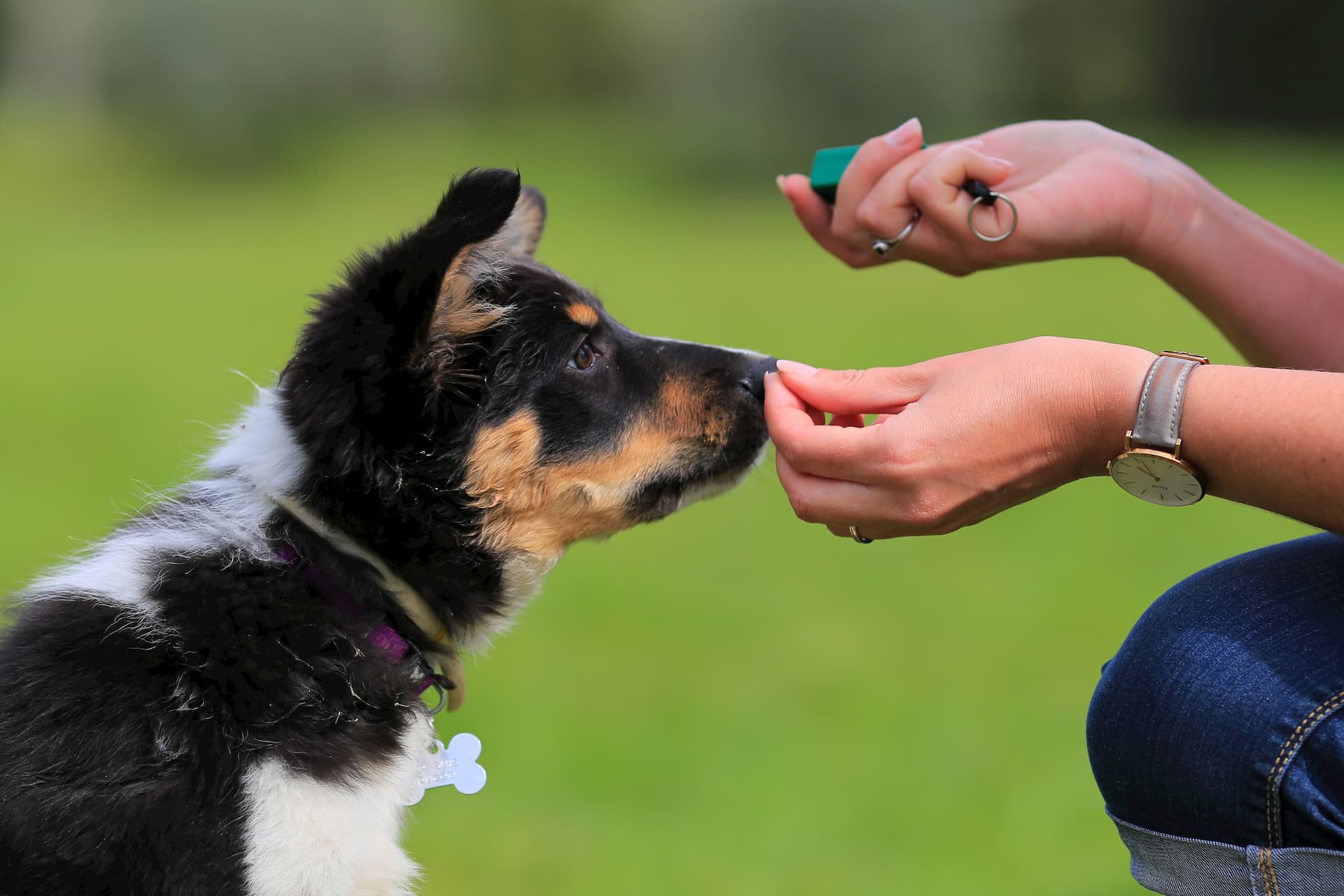Clicker training is getting more and more popular nowadays and it proves to be quite effective. So what is this magic clicker and why do dogs adore it?
A clicker is a small mechanical device that produces a sound when you click on it. Clickers come in a great variety, and you can even find dog training apps with built-in clickers.
Clickers have different volumes. There are quiet clickers which are used for training shy dogs and there are loud clickers which are used in noisy environments. There are also clickers with adjustable volume and clickers which allow working with two dogs at the same time.
There are clickers with a wrist strap and ring-shaped clickers which are attached to the finger, thus freeing the palm for working with the dog and rewarding them with treats.
The clicking sound marks the exact moment when a dog performs a desirable action which is going to be rewarded.
Once the dog understands that clicks are always followed by treats, the click becomes extremely powerful.
How does the clicker influence dog training?
It all depends on the human who uses the clicker. If you do everything correctly, the dog can learn the necessary skills very quickly. However, incorrect usage of the clicker may unwittingly slow down the learning process, preventing the dog from understanding what you want from them.
There is nothing magical about the clicker sound, it only serves as a correct behavioral marker and you could substitute any word or sound in its place. For example, you could cluck your tongue or use a marker word “Yes.”
When training basic obedience, you can do without an additional tool and use a verbal marker — a “code” word that you will use to indicate the correct dog’s actions. But when used correctly, the clicker can speed up training.
Why is it beneficial to use the clicker in training?
The concept behind clicker training is rather simple. If we touch a hot iron, will we first scream or pull our hand away? It is very likely that we’ll pull the hand away first. The same goes for the clicker. After noticing the dog’s desirable behavior, it is much faster to press the clicker button than wait while our brain receives information, processes it, “generates” the word, and our articulation apparatus finally pronounces this word. The mechanical response often outperforms the verbal one.
Some people find it inconvenient to work with the clicker and prefer to use a marker word but, after a few training exercises, a person learns to click in a timely manner.

There’s one more reason to decide in favor of using the clicker. Whatever the marker of the correct behavior is, the dog can hear it in everyday life, and this devalues its power. That is, the dog understands that “Yes” does not always mean that they are going to get a treat. This word doesn’t have as obvious an association with tasty rewards as the sound of a click does.
Because of our human nature, a verbal marker can be emotionally colored. We may sound enthusiastic, disappointed, or threatening. One simple word “Yes”, pronounced with different intonation, can have 18 meanings! A human understands that the word is the same, but a dog doesnt.
A dog may know what the word “Yes!” means, but they may have no idea what the word “Yeah” is about. Dogs do not understand semantics, they learn the sound form of a word, and it is we who give it a meaning.
Unlike words, the clicker is always neutral and always sounds the same. Whether we are angry, happy, have a headache, or think that “it’s okay, but we could have done better”, the clicker always sounds the same.
All of the above makes it easier for the dog to work with the clicker. But, again, that’s provided that you work correctly, that is, you send the signal during the desired behavior.
How can you avoid mistakes in clicker training?
Let’s take a look at the example. You want your dog to touch their nose with their paw. You’ve already placed the tape on your dog’s nose, the dog feels an unknown object, raises their paw, tries to scrape off the tape and touches their nose. We say “Ye-e-es”. The dog, after touching the nose for a split second, begins to lower their paw, hears our “Ye-e-es” and eats the offered treat with pleasure.
But what was the dog rewarded for? For touching the tip of their nose or for putting their paw down?
Let’s imagine that in this situation we use the clicker. Its sound is short and emotionless and here everything depends on the correct timing. If you manage to click at the moment the dog touches their nose with their paw — everything is fine. You clearly show the dog what behavior they are rewarded for.

If you click with a delay, and the dog hears the click when they start to move their paw down…oops! You’ve accidentally given encouragement at the moment of putting the paw down.
Your dog thinks: “I got it! I am rewarded for putting my paw down”. And you rack your brain trying to figure out why your dog doesn’t understand you.
When learning advanced commands that require timely encouragement, try shooting training sessions on video. When analyzing the video, you’ll see whether you’ve marked the correct behavior in a timely way or not.
If we compare the two situations described above, we’ll see that the clicker is a clearer and more accurate marker of correct behavior and that’s why it is worth using it in training sessions.
However, clicker training requires a clear and timely reaction. If you realized that you clicked at the wrong moment, give your dog a treat anyway. Giving out a piece, you will not bring the skill to automatism, but you won’t devalue the sound of the clicker either.
The golden rule of clicker training is “a click = a reward.”
That is, if you have already clicked, give your dog a treat.
How do you clicker train a dog?
Dogs get used to the clicker very quickly, virtually after 2 or 3 training sessions.
Take 20-25 small treats, make sure that the pieces are really small. The treat should be soft, and easy to swallow and chew.
Sit down next to your dog, click the clicker once and give your dog a treat. A click – a treat, a click – a treat and so on for 20-25 times. Remember, click first, then treat.
Make sure that you don’t click when your dog is eating and that you never give treats before a click. Remember that the click always comes first. Always click during the desired behavior, not after it is completed.
You can keep the food behind your back so that your dog does not become “hypnotized” with it. The dog hears a click, and a hand with a treat appears from behind.
Usually, the dog learns the connection between a click and a treat after a few training sessions.
It’s easy to check whether the reflex has formed: when the dog is bored or busy with something not particularly important or interesting, click and observe the reaction. If your dog turned their head to you with interest, or even came up to you, that’s great, the dog has learned the connection.
Now you need to explain to your dog that a click is not a sign that the dinner is served, but a marker of the correct behavior.
First, do some practice with the commands that your dog has already learned. For instance, the “Sit” command. Tell your dog to sit and as soon as they sit, click and give a treat. Ask your dog to give a paw if they are familiar with the “Paw” command. As soon as the dog touches your palm with their paw, give them a treat. Repeat this for several times.
Now you can use a clicker to teach your dog new skills. Do not forget about the three major components of clicker training: a click, a treat and a verbal or tactile praise.
A clicker is only a neutral (and this is important!) marker of your dog’s correct behavior. A click is always followed by a treat and it doesn’t mean that you shouldn’t praise your dog.
However, do not pet your dog during training when they are focused and working. Even dogs that adore tactile contact, try to escape it during intense and hard work.
All in good time. Your dog is doing their best to complete the task; they are focused and they try so hard. Your dog will appreciate your sincere joy, verbal praise, laughter and, of course, a tasty treat very much. You can pet your dog when the training session is over, they’ll be so happy to get a belly scratch.
Don’t forget about active and sincere verbal praise: this will provide your dog with social motivation. You will actively use this motivation, instead of clicks and treats, when the skill is mastered. Your dog will be highly motivated by the desire to hear “Good doggy!” from you.
How do you choose the right clicker?
If you decide to buy a clicker, you can go to a local pet store to select from a great variety of clickers presented there. Try the clicker before buying it to make sure its volume is fine and that the clicker is not very tight. Some of the clickers are so tight that it is almost impossible to use them during the training.
If you don’t fancy going to a pet store, you can download a dog training app with a built-in clicker. This is very convenient as built-in clickers have adjustable volume and are extremely easy to use.
